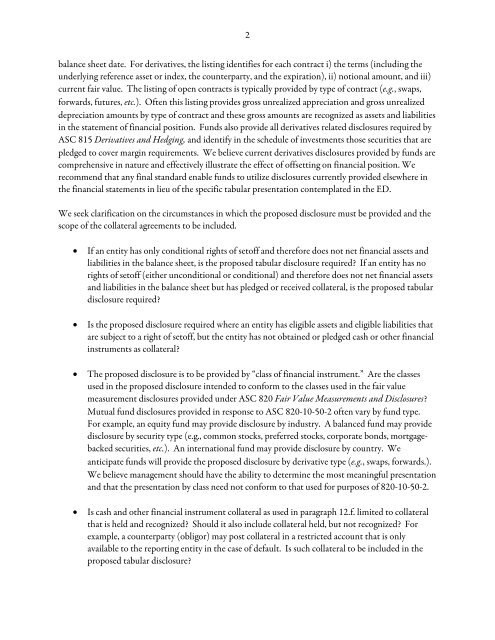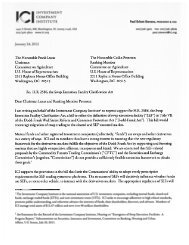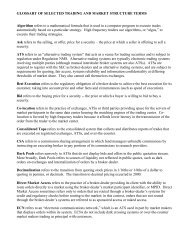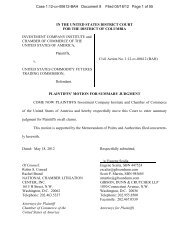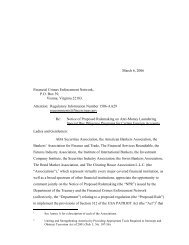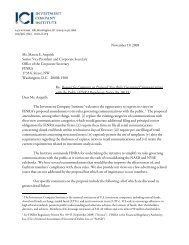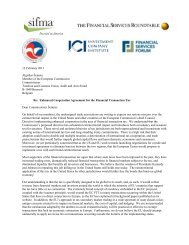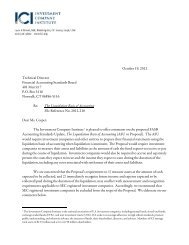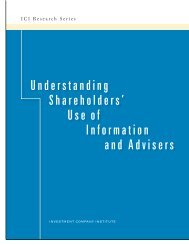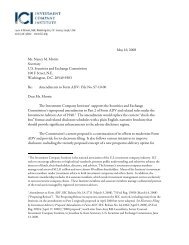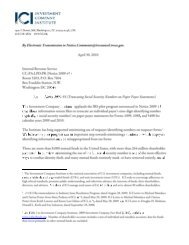Comments on FASB Balance Sheet Offsetting Proposal (pdf)
Comments on FASB Balance Sheet Offsetting Proposal (pdf)
Comments on FASB Balance Sheet Offsetting Proposal (pdf)
You also want an ePaper? Increase the reach of your titles
YUMPU automatically turns print PDFs into web optimized ePapers that Google loves.
2<br />
balance sheet date. For derivatives, the listing identifies for each c<strong>on</strong>tract i) the terms (including the<br />
underlying reference asset or index, the counterparty, and the expirati<strong>on</strong>), ii) noti<strong>on</strong>al amount, and iii)<br />
current fair value. The listing of open c<strong>on</strong>tracts is typically provided by type of c<strong>on</strong>tract (e.g., swaps,<br />
forwards, futures, etc.). Often this listing provides gross unrealized appreciati<strong>on</strong> and gross unrealized<br />
depreciati<strong>on</strong> amounts by type of c<strong>on</strong>tract and these gross amounts are recognized as assets and liabilities<br />
in the statement of financial positi<strong>on</strong>. Funds also provide all derivatives related disclosures required by<br />
ASC 815 Derivatives and Hedging, and identify in the schedule of investments those securities that are<br />
pledged to cover margin requirements. We believe current derivatives disclosures provided by funds are<br />
comprehensive in nature and effectively illustrate the effect of offsetting <strong>on</strong> financial positi<strong>on</strong>. We<br />
recommend that any final standard enable funds to utilize disclosures currently provided elsewhere in<br />
the financial statements in lieu of the specific tabular presentati<strong>on</strong> c<strong>on</strong>templated in the ED.<br />
We seek clarificati<strong>on</strong> <strong>on</strong> the circumstances in which the proposed disclosure must be provided and the<br />
scope of the collateral agreements to be included.<br />
• If an entity has <strong>on</strong>ly c<strong>on</strong>diti<strong>on</strong>al rights of setoff and therefore does not net financial assets and<br />
liabilities in the balance sheet, is the proposed tabular disclosure required? If an entity has no<br />
rights of setoff (either unc<strong>on</strong>diti<strong>on</strong>al or c<strong>on</strong>diti<strong>on</strong>al) and therefore does not net financial assets<br />
and liabilities in the balance sheet but has pledged or received collateral, is the proposed tabular<br />
disclosure required?<br />
• Is the proposed disclosure required where an entity has eligible assets and eligible liabilities that<br />
are subject to a right of setoff, but the entity has not obtained or pledged cash or other financial<br />
instruments as collateral?<br />
• The proposed disclosure is to be provided by “class of financial instrument.” Are the classes<br />
used in the proposed disclosure intended to c<strong>on</strong>form to the classes used in the fair value<br />
measurement disclosures provided under ASC 820 Fair Value Measurements and Disclosures?<br />
Mutual fund disclosures provided in resp<strong>on</strong>se to ASC 820-10-50-2 often vary by fund type.<br />
For example, an equity fund may provide disclosure by industry. A balanced fund may provide<br />
disclosure by security type (e.g., comm<strong>on</strong> stocks, preferred stocks, corporate b<strong>on</strong>ds, mortgagebacked<br />
securities, etc.). An internati<strong>on</strong>al fund may provide disclosure by country. We<br />
anticipate funds will provide the proposed disclosure by derivative type (e.g., swaps, forwards.).<br />
We believe management should have the ability to determine the most meaningful presentati<strong>on</strong><br />
and that the presentati<strong>on</strong> by class need not c<strong>on</strong>form to that used for purposes of 820-10-50-2.<br />
• Is cash and other financial instrument collateral as used in paragraph 12.f. limited to collateral<br />
that is held and recognized? Should it also include collateral held, but not recognized? For<br />
example, a counterparty (obligor) may post collateral in a restricted account that is <strong>on</strong>ly<br />
available to the reporting entity in the case of default. Is such collateral to be included in the<br />
proposed tabular disclosure?


